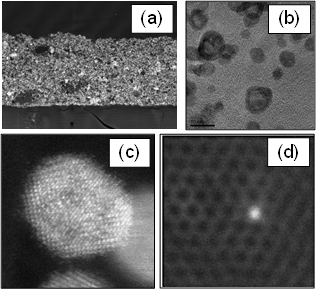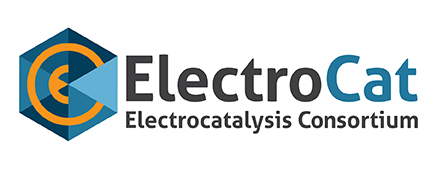| Laboratory: | Oak Ridge National Laboratory (ORNL) |
| Capability Expert: | Karren L. More |
| Capability Details: | |
| Title: | High-resolution analytical scanning transmission electron microscopy (STEM) |
| Class: | Characterization |
| Description: | High-resolution transmission electron microscopy (TEM) and aberration-corrected scanning transmission electron microscopy (STEM) are microscopy methods used to characterize the atomic-scale structure of PGM-free catalysts (typically in powder form) and the material constituents (catalyst and ionomer) comprising membrane electrode assemblies (MEAs). STEM instruments are typically equipped with multiple detectors, including high angle annular dark field (HAADF) detectors to perform what is commonly referred to as Z-contrast STEM imaging (where Z refers to the atomic number), bright field (BF) detectors, and spectrometers (e.g., an electron energy loss spectrometer (EELS) and an energy dispersive X-ray spectrometer (EDS)). These detectors and spectrometers, when used in combination, enable the simultaneous study of the atomic structure and chemistry of novel PGM-free catalyst systems and their interfaces with other MEA constituents from the bulk-scale to the single atom level. Compositions and chemistries can be acquired and mapped (spectral imaging) across multiple length scales and directly correlated with the atomic structure determined through HAADF/BF-STEM imaging. |
| Capability Bounds: | NA |
| Unique Aspects: |
A full suite of scanning transmission electron microscopes (STEM) is available at ORNL for conducting imaging and spectroscopic analysis of PGM-free catalysts and membrane electrode assemblies (MEAs) from the bulk-scale to the single-atom level, including the identification of unique morphologies of catalyst particles and insight towards understanding the atomic structure of catalytically active sites. Unique microscopes include low-voltage (60kV) and high-voltage (200kV) aberration-corrected STEM instruments equipped with high-energy resolution electron energy loss spectroscopy (EELS) and high spatial-resolution energy dispersive X-ray spectroscopy (EDS), which enable a broad range of structural, chemical, and compositional analyses of newly developed PGM-free catalysts, MEA characterization including ionomer mapping, and microstructural changes occurring as a result of fuel cell testing. Analytical STEM requires reproducible methods for preparing highly dispersed, clean powder specimens and ultra-thin MEA cross-sections. ORNL’s microscopy laboratories are fully equipped with state of the art sample preparation instruments, including a new Leica Ultramicrotome for diamond knife sectioning of intact MEAs. |
| Availability: | Instruments in ORNL’s Materials Characterization Center (MCC) are available for partnership with industry through Strategic Partnership Projects (SPP), cooperative research and development agreements (CRADAs) via full-cost recovery (hourly fee), and direct project collaborations to facilitate new materials discovery and understanding; instruments in ORNL’s Center for Nanophase Materials Sciences (CNMS – a U.S. DOE Office of Science User Facility) are accessible through a peer-reviewed proposal process (no cost if results are publishable and full-cost recovery if data is proprietary). All instruments in the MCC and CNMS are available for characterization of PGM-free catalysts and MEAs. |
| References: |
G. Wu, K.L. More, C.M. Johnston, and P. Zelenay, “High-Performance Electrocatalysts for Oxygen Reduction Derived from Polyanilene, Iron, and Cobalt,” Science 332 443-447 (2011). W. Gao, G. Wu, M.T. Janicke, D.A. Cullen, R. Mukundan, J.K. Baldwin, E.L. Brosha, C. Garlande, P.M. Ajayan, K.L. More, A.M. Dattlebaum, and P. Zelenay, “Ozonated Graphene Oxide Film as a Proton Exchange Membrane,” Angewandte Chemie International Edition 53[14] 3588-3593 (2014). G. Wu, K.L. More, P. Xu, H.L. Wang, M. Ferrandon, A.J. Kropf, D.J. Myers, S. Ma, C.M. Johnston, and P. Zelenay, “A Carbon-nanotube-supported Graphene-rich Non-precious Metal Oxygen Reduction Catalyst with Enhanced Performance Durability,” Chemical Communications 49 3291-3293 (2013). |
| Benefit: | ORNL’s unique STEM instruments provide capabilities for the complete analytical and structural characterization of PGM-free catalysts and MEAs at multiple length scales to correlate structure and chemistry with material performance. |

(a) HAADF-STEM image of ~5 m thick catalyst layer cross-section, (b) BF-STEM image of ~5-7 nm alloy nanoparticles within catalyst layer, (c) HAADF-STEM image of a 6 nm core-shell Pt-alloy nanoparticle, and (d) single Fe atom embedded within few-layer graphene in PGM catalyst.
